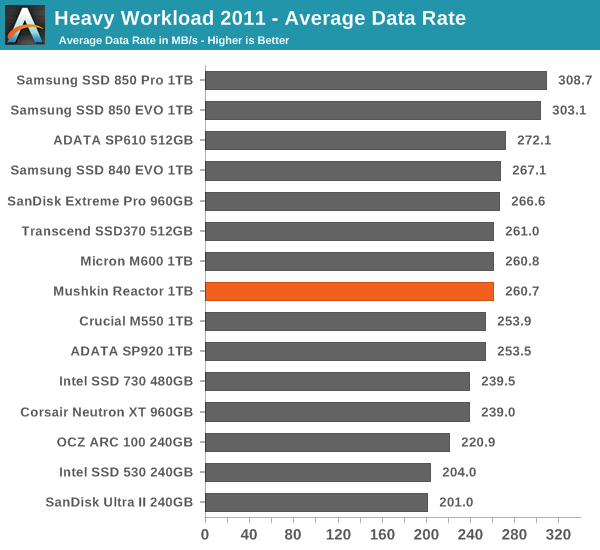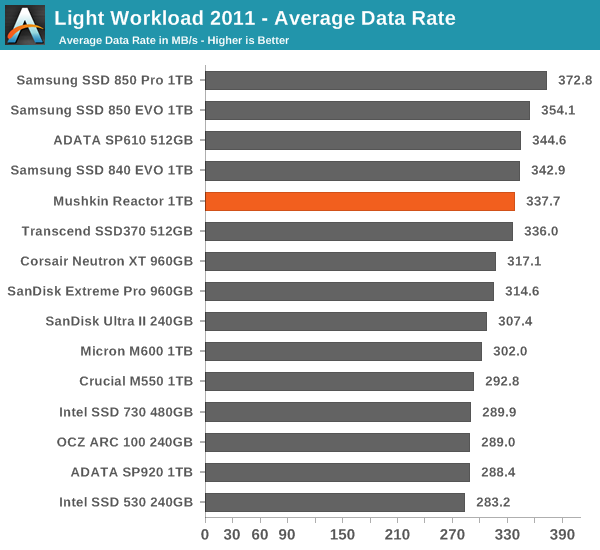Mushkin Reactor 1TB SSD Review
by Kristian Vättö on February 9, 2015 11:32 AM EST- Posted in
- Storage
- SSDs
- Mushkin
- Silicon Motion
- SM2246EN
- Reactor
- Micron 16nm
AnandTech Storage Bench 2011
Back in 2011 (which seems like so long ago now!), we introduced our AnandTech Storage Bench, a suite of benchmarks that took traces of real OS/application usage and played them back in a repeatable manner. The MOASB, officially called AnandTech Storage Bench 2011 – Heavy Workload, mainly focuses on peak IO performance and basic garbage collection routines. There is a lot of downloading and application installing that happens during the course of this test. Our thinking was that it's during application installs, file copies, downloading and multitasking with all of this that you can really notice performance differences between drives. The full description of the Heavy test can be found here, while the Light workload details are here.

The strong performance continues in our 2011 Storage Benches. Only Samsung has found the secret recipe to providing noticeable performance gains, whereas the majority of other drives are very close and that applies to the Reactor as well.











69 Comments
View All Comments
Hulk - Monday, February 9, 2015 - link
When it's written as 131GB writes/day for 3 years it seems like more than enough.But cell endurance of 144 writes seems really, really low.
hojnikb - Monday, February 9, 2015 - link
It doesnt work like that. 144TB for 1TB doesn't translate to 144 p/e flash. You have to factor in write amplification, which can be more than 1 on controller like this.Also conservative rating is nothing new with budget driver.
cm2187 - Friday, February 13, 2015 - link
Stupid question: has anyone any experience with SSD reliability over time. I.e. is it reliable to store static data 3-5y+? Or does the 3y (or 5y) guarantee also means the data should be migrated out after that period even if the number of writes has been low?hojnikb - Monday, February 9, 2015 - link
Its just a conservative rating for warranty purposes. Besides, other value drives are no better at this (evo is only "good" for 150TB).In reality, drives typically last many times the rated endurance.
DanNeely - Monday, February 9, 2015 - link
More importantly, it's set low to scare off enterprise customers who'd subject the drive to an order of magnitude more IO.toyotabedzrock - Monday, February 9, 2015 - link
So if the endurance is 144TB on a 1TB drive, they are predicting the nand can only take 144 writes?That is a bit scary for even home use. I wouldn't trust my data to that.
zepi - Monday, February 9, 2015 - link
There is not a single medium or drive out there that you should trust your data on. Only thing you can trust is redundancy.hojnikb - Monday, February 9, 2015 - link
No. Read my post above ^^TheinsanegamerN - Monday, February 9, 2015 - link
the 512GB crusial mx 100 endurance is only 72TB, yet people dont seem to be complaining. besides, as typical day to day use only accounts for maybe ~10GB or writes(3.65TB a year), the 144TB endurance will last far longer than the machine it is put in.Murloc - Monday, February 9, 2015 - link
yeah problem is that until it's broken, I'll keep moving it on to the next machine.But I write about 1 GB/week to the SSD so I should be safe, unless windows does a lot of that in the background, I don't know, I just deactivated all the bad stuff I read about.